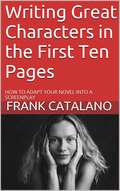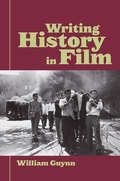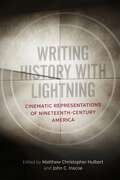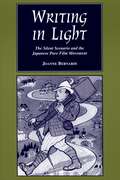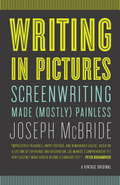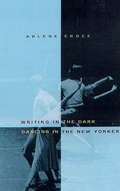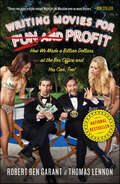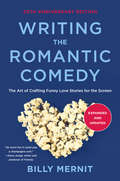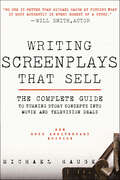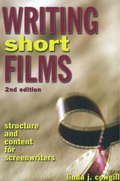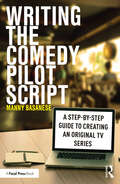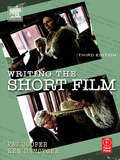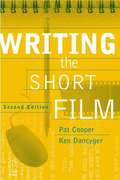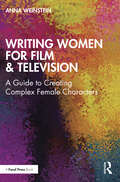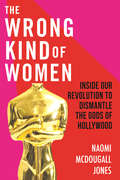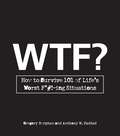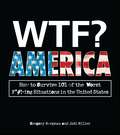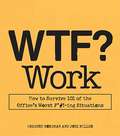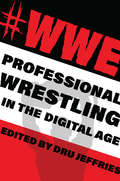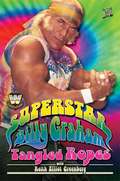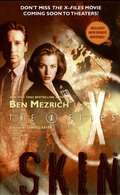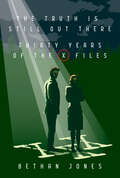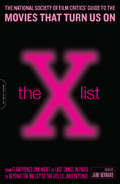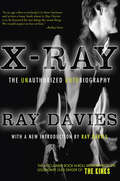- Table View
- List View
Writing Great Characters in the First Ten Pages: How to Adapt Your Novel Into a Screenplay
by Frank CatalanoWriters of fiction and non-fiction and industry professionals from the publishing business primarily attended the 25th Annual Writer's Conference. Mr. Catalano's seminars focused upon those writers seeking to adapt their novels into screenplays. The complete list of seminar presentations by Frank Catalano for this conference is: BOOK 1: WRITE GREAT CHARACTACTERS IN THE FIRST TEN PAGES BOOK 2: WRITING ON YOUR FEET - IMPROVISATIONAL TECHNIQUES FOR WRITERS BOOK 3: START YOUR STORY AT THE END: FOR WRITERS BOOK 4: THE FIRST TEN PAGES BOOK 5: BOOK TO SCREEN BOOK 6: ACTING IT OUT - IMPROVISATIOINAL TECHNIQUES FOR WRITERS II BOOK 7: WRITE GREAT DIALOGUE
Writing History in Film
by William GuynnHistorical film has been an important genre since the earliest silent films. The French Revolution, the American Civil War, the conquest of the New World, World War II--all have been repeatedly represented in film. But how do we distinguish between fictionalized spectacle and authentic historical representation? Writing History in Film sets out the narratological, semiological, rhetorical, and philosophical bases for understanding how film can function as a form of historical interpretation and representation. With case studies and an interdisciplinary approach, William Guynn examines the key issues facing film students and scholars, historians, and anyone interested in how we see our historical past.
Writing History with Lightning: Cinematic Representations of Nineteenth-Century America
by Matthew C. Hulbert John C. Inscoe Kenneth Greenberg William L. Andrews Lesley J. Gordon John David Smith Jonathon Sarris Catherine Clinton John F. Marszalek Ryan Keating Joseph Beilein Brian Rouleau Donna Barbie Allison Dorsey Stephen Whitfield Marcus Rediker Nicole Etcheson Diane Miller Sommerville Graham Hodges Drew Swanson Michael Burlingame Tom Lee James Crisp Matthew Stanley Kevin Waite Jacob LeeFilms possess virtually unlimited power for crafting broad interpretations of American history. Nineteenth-century America has proven especially conducive to Hollywood imaginations, producing indelible images like the plight of Davy Crockett and the defenders of the Alamo, Pickett’s doomed charge at Gettysburg, the proliferation and destruction of plantation slavery in the American South, Custer’s fateful decision to divide his forces at Little Big Horn, and the onset of immigration and industrialization that saw Old World lifestyles and customs dissolve amid rapidly changing environments. Balancing historical nuance with passion for cinematic narratives, Writing History with Lightning confronts how movies about nineteenth-century America influence the ways in which mass audiences remember, understand, and envision the nation’s past. In these twenty-six essays—divided by the editors into sections on topics like frontiers, slavery, the Civil War, the Lost Cause, and the West—notable historians engage with films and the historical events they ostensibly depict. Instead of just separating fact from fiction, the essays contemplate the extent to which movies generate and promulgate collective memories of American history. Along with new takes on familiar classics like Young Mr. Lincoln and They Died with Their Boots On, the volume covers several films released in recent years, including The Revenant, 12 Years a Slave, The Birth of a Nation, Free State of Jones, and The Hateful Eight. The authors address Hollywood epics like The Alamo and Amistad, arguing that these movies flatten the historical record to promote nationalist visions. The contributors also examine overlooked films like Hester Street and Daughters of the Dust, considering their portraits of marginalized communities as transformative perspectives on American culture. By surveying films about nineteenth-century America, Writing History with Lightning analyzes how movies create popular understandings of American history and why those interpretations change over time.
Writing in Light: The Silent Scenario and the Japanese Pure Film Movement
by Joanne BernardiWhile most people associate Japanese film with modern directors like Akira Kurosawa, Japan's cinema has a rich tradition going back to the silent era. Japan's "pure film movement" of the 1910s is widely held to mark the birth of film theory as we know it and is a touchstone for historians of early cinema. Yet this work has been difficult to access because so few prints have been preserved. Joanne Bernardi offers the first book-length study of this important era, recovering a body of lost film and establishing its significance in the development of Japanese cinema. Building on a wealth of original-language sources--much of it translated here for the first time--she examines how the movement challenged the industry's dependence on pre-existing stage repertories, preference for lecturers of intertitles, and the use of female impersonators. Bernardi provides in-depth analysis of key scripts--The Glory of Life, A Father's Tears, Amateur Club, and The Lust of the White Serpent--and includes translations in an appendix. These films offer case studies for understanding the craft of screenwriting during the silent era and shed light on such issues as genre, authorship and control, and gender representation. Writing in Light helps fill important gaps in the history of Japanese silent cinema. By identifying points at which "pure film" discourse merges with changing international trends and attitudes toward film, it offers an important resource for film, literary, and cultural historians.
Writing in Pictures
by Joseph McbrideWriting in Pictures is a refreshingly practical and entertaining guide to screenwriting that provides what is lacking in most such books: a clear, step-by-step demonstration of how to write a screenplay.Seasoned screenwriter and writing teacher Joseph McBride breaks down the process into a series of easy, approachable tasks, focusing on literary adaptation as the best way to learn the basics and avoiding the usual formulaic approach. With its wealth of useful tips, along with colorful insights from master screenwriters past and present, this book is invaluable for anyone who wants to learn the craft of screen storytelling.
Writing in the Dark, Dancing in the New Yorker
by Arlene CroceArlene Croce was The New Yorker's dance critic, a post created for her. Her entertaining, forthright, passionate reviews have revealed the logic and history of ballet, modern dance, and their postmodern variants to a generation of theatergoers.
Writing Movies for Fun and Profit: How We Made a Billion Dollars at the Box Office and You Can, Too!
by Robert Ben Garant Thomas LennonThis isthe only screenwriting guide by two guys who have actually done it (instead of some schmuck who just gives lectures about screenwriting at the airport Marriott); “These guys are proof that with no training and little education, ANYONE can make it as a screenwriter” (Paul Rudd).Robert Ben Garant and Thomas Lennon’s movies have made over a billion dollars at the box office—and now they show you how to do it yourself! This book is full of secret insider information about how to conquer the Hollywood studio system: how to write, pitch, structure, and get drunk with the best of them. Well…maybe not the best of them, but certainly the most successful. (If you’re aiming to win an Oscar, this is not the book for you!) But if you can type a little, and can read and speak English—then you too can start turning your words into stacks of money!This is the only screenwriting book you will ever need (because all other ones pretty much suck). In these pages, Garant and Lennon provide the kind of priceless tips you won’t find anywhere else, including:-The art of pitching -Getting your foot in the door -Taking notes from movie stars -How to get fired and rehired -How to get credit and royalties!And most important: what to buy with the huge piles of money you’re going to make!Writing Movies for Fun and Profit will take you through the highs and lows of life as a professional screenwriter. From the highs of hugging Gisele Bündchen and getting kung fu punched by Jackie Chan to the soul-crushing lows of Herbie: Fully Loaded.Read this book and you’ll have everything you need to make your first billion the old-fashioned way—by “selling out” in show business!A portion of the authors’ proceeds from this book are being contributed to the USO of Metropolitan Washington, a private, nonprofit organization dedicated to serving active duty military members and their families in the greater Washington, DC, region.
Writing The Romantic Comedy, 20th Anniversary Expanded and Updated Edition: The Art of Crafting Funny Love Stories for the Screen
by Billy Mernit“Writing the Romantic Comedy is so much fun to read it could pop a champagne cork.”—Alexa Junge, writer and producer of FriendsRevised and expanded to celebrate a new generation of romantic comedies, Billy Mernit’s insightful look into the mechanics of writing Hollywood’s most enduring genre features case studies that reveal the screenwriting secrets behind classics new and old.Whether you’re a first-time screenwriter, an intermediate marooned in the rewriting process, or a professional wanting to explore the latest genre trends, this thoroughly charming and insightful guide to the basics of crafting a winning and innovative script will take you step by step from “meet cute” all the way to “joyous defeat.” You’ll learn the screenwriting secrets behind some of the funniest scenes ever written; how to create characters and dialogue that getsparks flying; why some bedroom scenes sizzle and others fall flat; and much more. Written in a refreshingly accessible style and updated and expanded to recognize the contributions of a fresh generation of romantic comedies, this newly revised 20th Anniversary edition of Writing the Romantic Comedy features case studies drawn from beloved romantic classics such as When Harry Met Sally, Annie Hall, Tootsie, and The Lady Eve to modern-day favorites including Hitch, (500) Days of Summer, Bridesmaids, and Silver Linings Playbook. Field-tested writing exercises are also included, guaranteed to short-circuit potential mistakes and ensure inspiration.
Writing Screenplays That Sell: The Complete Guide to Turning Story Concepts into Movie and Television Deals
by Michael HaugeFor more than twenty years, Writing Screenplays That Sell has been hailed as the most complete guide available on the art, craft, and business of writing for movies and television. Now fully revised and updated to reflect the latest trends and scripts, Hollywood story expert and script consultant Michael Hauge walks readers through every step of writing and selling successful screenplays. If you read only one book on the screenwriter's craft, this must be the one.
Writing Short Films: Structure and Content for Screenwriters
by Linda J. CowgillThis new edition has been completely updated and revised along with the addition of several new chapters. Currently, this title remains the best selling university text book on writing short film screenplays.
Writing the Comedy Pilot Script: A Step-by-Step Guide to Creating an Original TV Series
by Manny BasaneseNavigating through the challenging process of writing a comedy pilot, this book will help screenwriters to create an original script for television. Practical and accessible, the book presents a step-by-step guide focusing on the key elements of the process. Incorporating both the history of TV comedy as well as its current evolving state in this age of the dramedy and an ever-increasing variety of broadcast and streaming platforms, the book will serve as a guide for the fledgling sitcom scribe. Author Manny Basanese breaks down the comedy pilot writing process from what may be perceived as an overwhelming, time-consuming mission into a series of much more manageable, smaller steps (from logline to outline to 1st, 2nd and polished draft). Utilizing his experience in Hollywood’s sitcom trenches, the author offers real-world advice on such topics as building the comedy pilot "world," creating memorable comic characters, sound sitcom structure, and the importance of crafting an emotional through line in a comedy pilot. Finally, there is also practical career guidance for marketing this just-completed script and breaking into the industry with advice on various topics such as the value of networking as well as gaining representation in the competitive Hollywood jungle. It is ideal for students of screenwriting and aspiring comedy screenwriters.
Writing the Short Film
by Ken Dancyger Patricia CooperThe short film is a unique narrative art form that, while lending itself to experimentation, requires tremendous discipline in following traditional filmic considerations. This book takes the student and novice screenwriter through the storytelling process- from conception, to visualization, to dramatization, to characterization and dialogue- and teaches them how to create a dramatic narrative that is at once short (approximately half an hour in length) and complete. Exercises, new examples of short screenplays, and an examination of various genres round out the discussion.NEW TO THE THIRD EDITION: new screenplays, a chapter on rewriting your script, and a chapter on the future of short films
Writing the Short Film (second edition)
by Ken Dancyger Pat CooperWriters who want to write a fil will find this to be a useful book. The usefulness of this book goes beyond the writing or filmmaking class.
Writing Women for Film & Television: A Guide to Creating Complex Female Characters
by Anna WeinsteinThis book is a detailed guide to creating complex female characters for film and television. Written for screen storytellers of any level, this book will help screenwriters and filmmakers recognize complicated portrayals of women on screen and evaluate the complexity of their own characters. Author Anna Weinstein provides a thorough analysis of key female characters in film and television, illustrating how some of our greatest screenwriters have developed smart, nuanced, and intriguing characters that successfully portray the female experience. The book features in-depth discussions of women’s representation both on screen and behind the scenes, including interviews with acclaimed women screenwriters and directors from around the globe. These conversations detail their perspectives on the relevance of women’s screen stories, the writing and development processes of these stories, and the challenges in getting female characters to the screen. With practical suggestions, exercises, guidelines, and a review of tired clichés to avoid, this book leaves readers prepared to draw their own female characters with confidence. A vital resource for screenwriters, filmmakers, and directors, whether aspiring or already established, who seek to champion the development of rich, layered, and unforgettable female characters for film and television.
The Wrong Kind of Women: Inside Our Revolution to Dismantle the Gods of Hollywood
by Naomi McDougall JonesA brutally honest look at the systemic exclusion of women in film--an industry with massive cultural influence--and how, in response, women are making space in cinema for their voices to be heard.Generation after generation, women have faced the devastating reality that Hollywood is a system built to keep them out. The films created by that system influence everything from our worldviews to our brain chemistry. When women's voices are excluded from the medium, the impact on society is immense. Actor, screenwriter, and award-winning independent filmmaker Naomi McDougall Jones takes us inside the cutthroat, scandal-laden film industry, where only 5% of top studio films are directed by women and less than 20% of leading characters in mainstream films are female. Jones calls on all of us to act radically to build a different kind of future for cinema--not only for the women being actively hurt inside the industry but for those outside it, whose lives, purchasing decisions, and sense of selves are shaped by the stories told. Informed by the journey of her own career; by interviews with others throughout the film industry; and by cold, hard data, Jones deconstructs the casual, commonplace sexism rampant in Hollywood that has kept women out of key roles for decades. Next, she shows us the growing women-driven revolution in filmmaking--sparked by streaming services, crumbling distribution models, direct-to-audience access via innovative online platforms, and outside advocacy groups--which has enabled women to build careers outside the traditional studio system. Finally, she makes a business case for financing and producing films by female filmmakers.
WTF?
by Gregory Bergman Anthony W. HaddadAs if your HR Department didn't have enough to worry about, WTF? is holding its own office orientation. From dealing with workplace politics and romancing coworkers to climbing the success ladder or getting canned, WTF? Work shows you how to handle the daily lows of holding down a j-o-b. Whether you're sitting in the cubes or in the corner office, working the counter or bussing the tables, WTF? provides an employee handbook that's actually worth reading. It leaves the PC stuff to the professionals and instead delivers some not-safe-for-work advice for when your job has you saying, "WTF?" For even more f*#!-ing fun, visit www. WTFComedyStop. com
WTF? America
by Gregory Bergman Jodi MillerAmerica: The land of the free . . . and the home of the totally f*#!ed. Whether you made the mistake of messing with (a drunk guy in a bar from) Texas or a Red Sox fan spit on your car just for having New York plates, the mighty U. S. of A. is sure to screw over everyone at some point or another. But hey, these colors don't run--and that's where Gregory Berman and Jodi Miller come in. Join the authors of the bestselling WTF? series on a state-by-state road trip through our greatly infuriating nation. Whether you're trying to figure out how to stay in shape in America's fattest state (Mississippi) or just want to dodge your town's local "smog tax," this survival guide is certain to entertain. From sea to polluted sea, it's exactly what you need when America has you screaming, "What the f*#!?"
WTF? Work
by Gregory Bergman Jodi MillerAs if your HR Department didn't have enough to worry about, WTF? is holding its own office orientation. From dealing with workplace politics and romancing coworkers to climbing the success ladder or getting canned, WTF? Work shows you how to handle the daily lows of holding down a j-o-b. Whether you're sitting in the cubes or in the corner office, working the counter or bussing the tables, WTF? provides an employee handbook that's actually worth reading. It leaves the PC stuff to the professionals and instead delivers some not-safe-for-work advice for when your job has you saying, "WTF?" For even more f*#!-ing fun, visit www. WTFComedyStop. com
#Wwe: Professional Wrestling in the Digital Age (The Year's Work: Studies in Fan Culture and Cultural Theory)
by Dru JeffriesThe millions of fans who watch World Wrestling Entertainment (WWE) programs each year are well aware of their role in building the narrative of the sport. #WWE: Professional Wrestling in the Digital Age explores the intersections between media, technology, and fandom in WWE's contemporary programming and business practices. In the Reality Era of WWE (2011 to the present), wrestling narratives have increasingly drawn on real-life personalities and events that stretch beyond the story-world created and maintained by WWE. At the same time, the internet and fandom have a greater influence on the company than ever before. By examining various sites of struggle and negotiation between WWE executives and in-ring performers, between the product and its fans, and between the company and the rest of the wrestling industry, the contributors to this volume highlight the role of various media platforms in shaping and disseminating WWE narratives. Treating the company and its product not merely as sports entertainment, but also as a brand, an employer, a company, a content producer, and an object of fandom, #WWE conceptualizes the evolution of professional wrestling's most successful company in the digital era.
WWE Legends - Superstar Billy Graham
by Billy Graham Keith Elliot Greenberg"I'm the man of the hour," Superstar Billy Graham told his audiences, "the man with the power. Too sweet to be sour!" Despite years of devastating health issues (a long history of drug abuse led to a liver transplant in 2002), the man regarded as one of the most influential professional wrestlers of the past thirty years still flaunts the same optimism that made his interviews as compelling as his matches. In Tangled Ropes, his autobiography, Graham remembers his victories -- and his setbacks -- on both the wrestling and the evangelism circuits in vibrant detail. At his core, Graham is still Wayne Coleman, the artistic, curious boy who escaped the wrath of his disabled father in post-war Phoenix through painting, sports, and bodybuilding. When his photo appeared in a bodybuilding magazine, the young man caught the attention of a family in Texas who began praying for his soul. Soon, Wayne found religion at a revival meeting, then mortified his parents as he left home to bend steel, rip phone books in half, and preach the Gospel on the back roads of America. Because of his natural athleticism, Wayne held a series of jobs -- from bouncer to boxer, from repo man to football player. However, it was under the training of the "Mentor of Mayhem," Stu Hart, that the wrestler was revealed. Then the fading headliner Dr. Jerry Graham bleached Wayne's hair blond and transformed him into an in-ring "brother." Still reverent of men of faith, Coleman became "Billy Graham," after the preacher. Graham completed the package with his golden tan and enormous "pythons," a succession of color-coordinated outfits and jive-talking -- a persona imitated by countless wrestlers, including Hulk Hogan and Jesse "The Body" Ventura. The Superstar's greatest wrestling achievement came in 1977, when he took the World Wide Wrestling Federation Championship from Bruno Sammartino. He held the prize for nearly a year -- the first wrestling villain to do so. But after he lost the title to wholesome Bob Backlund, Graham fell into a deep depression. He disappeared from the business, squandering his money and losing himself in a haze of drugs. In Tangled Ropes -- co-written with Keith Elliot Greenberg -- Superstar Billy Graham tells a story that transcends his life in the wrestling profession, offering candor, nostalgia, inspiration, and humor. Graham's narrative is supplemented by anecdotes from personalities like Vince McMahon, Jesse Ventura, Ivan Koloff, Ric Flair, Dusty Rhodes, and California governor Arnold Schwarzenegger.
WYXIE Wonderland: An Unauthorized 50-Year Diary of WXYZ Detroit
by Dick OsgoodWYXIE WONDERLAND, by Dick Osgood, is a good time and more than that. Here is possibly the first comprehensive exploration into the inner workings of a broadcasting enterprise. It is as broad as it is deep, revealing the secrets of top management as completely as--perhaps even more fully than--it does the vagaries of performing talent. It is not a purely local story. Fifty years of national radio and television history--1925-1975--are reflected in the fundamental and accidental specifics of a single station--WXYZ, Detroit-AM, FM and TV. This is the diary of that station, unauthorized and independently written. WYXIE WONDERLAND was much more than the birthplace of The Lone Ranger, The Green Hornet and Sergeant Preston of the Yukon. It was the starting point of SOUPY SALES and MIKE WALLACE, of DOUGLAS EDWARDS and JOHN HODIAK, of GEORGE SEATON, MARTHA SCOTT and DANNY THOMAS. Here are the hilarious fluffs, minor on-the-air disasters and a phantom broadcast. This extraordinary book traces the beginnings of five networks; it follows the rise and decline of radio network programming. It sees the radio actor replaced by--the disc jockey. There are record hops with FABIAN, CHUCK BERRY and STEVIE WONDER. WYXIE WONDERLAND explains how the scandal of radio payola grew out of the discovery of rigged TV quiz programs. It tells of a sound created in Texas that revolutionized radio, and how the Top 40 format emerged from a bar in Omaha. The confusion of early television is in it as well as of early radio, and the nefarious underground beginnings of FM. Alcoholism is discovered to be something of an occupational disease. The infighting among stations and executives for ratings, accounts and position gets tough. Personalities clash. There are victories and surprising defeats.
The X-Files: Skin
by Ben MezrichWhen moonlighting medical students "harvesting" skin from a corpse for temporary use accidentally take it from the wrong donor, the results are catastrophic: a New York City hospital ward is destroyed in a bloodbath, and an elderly professor, admitted for a routine skin graft, is suddenly the city's most wanted fugitive.Agents Fox Mulder and Dana Scully are the only ones to suspect something more ominous than a medical procedure gone awry. As the FBI agents investigating the "X-Files"--strange and inexplicable cases the Bureau wants to keep hidden--Mulder and Scully are determined to track down the forces they suspect are behind the murderer.While the police hunt the fleeing professor, Mulder and Scully track the skin that was grafted onto him, a trail that leads from the morgue to the headquarters of a cutting-edge biotech company to the jungles of Thailand. Together they begin to uncover an unholy and totally deniable alliance between a battle-trained plastic surgeon, international politicians, and a legendary Thai monster known as the "Skin-Eater."
The X-Files The Truth is Still Out There: Thirty Years of The X-Files
by Bethan JonesIn September 1993, a TV show like no other appeared on our screens, asking us to consider the essence of truth and belief, to think about the nature and roles of science and humanity, and to question what we were told by those in power. Combining horror, science fiction, drama, crime, and comedy with cinematic filmmaking, The X-Files transported the paranoia of the sixties and seventies to the technologically savvy nineties as it followed two iconic characters, FBI Agents Fox Mulder and Dana Scully, in their labyrinthine pursuit of truth. Further, The X-Files reversed conventional television gender roles: Mulder was our believer in the paranormal, chasing down clues in search of his abducted sister; Scully was the skeptic, a scientist preaching rationality and objective truth. Now, thirty years later, the nature of conspiracy theories may have changed, but the anxiety surrounding them has not. In an era in which Watergate has been replaced by Gamergate and conspiracy theorists blindly embrace the myth of a stolen election and maintain that an all-powerful cabal of Satanic Democrats—defeatable by only one man—is preying on children, The X-Files remains as relevant as ever, if not more so. Conspiracy theorists are no longer on the fringes of society; they sit in halls of fame, in corridors of schools and universities, and at the heart of government, and The X-Files reflects these apprehensions back at us. Part love letter, part history, part analysis, The Truth Is Still Out There: Thirty Years of The X-Files examines the social, cultural, and technological impact of the show. Using big ideas from philosophy, sociology, and cultural studies and topical issues such as #MeToo, QAnon, and artificial intelligence, the book highlights how and why The X-Files became a global phenomenon. Drawing on both her own fandom and her academic research, Bethan Jones analyzes the original nine seasons as well as the two feature films and the revival series to explore how the show helps us think about the most provocative questions of our time.
The X List: The National Society of Film Critics' Guide to the Movies That Turn Us On
by Jami BernardNational Society of Film Critics dares to go where few mainstream critics have gone before-to the heart of what gets the colored lights going, as they say in A Streetcar Named Desire. Here is their take on the films that quicken their (and our) pulses-an enterprise both risky and risque, an entertaining overview of the most arousing films Hollywood has every produced. But make no mistake about it: This isn't a collection of esoteric "critic's choice" movies. The films reflect individual taste, rubbing against the grain of popular wisdom. And, because of the personal nature of the erotic forces at play, these essays will reveal more about the individual critics than perhaps they have revealed thus far to their readers. The Society is a world-renowned, marquee-name organization embracing some of America's most distinguished critics, more than forty writers who have followings nationally as well as devoted local constituencies in such major cities as New York, Chicago, Los Angeles, Boston, Philadelphia, Atlanta, and Minneapolis. Yes, The X List will have something for every lover of film-and for every lover.
X-Ray: The Unauthorized Autobiography
by Ray DaviesThe shocking and edgy memoirs of a dedicated enemy of fashion and the lead singer of The Kinks. This subversively brilliant, one-of-a-kind rock autobiography ingeniously styled as a biography, is written by a nameless, faceless writer hired by an Orwellian entity called "the Corporation" to capture the essence of Ray Davies, lead singer and songwriter of The Kinks and one of the greatest rock and rollers of all time. The Kinks front man reveals his life and times to the young writer, often seemingly passing his stories directly into the writer's consciousness. Carnaby Street, "Top of the Pops," the Cavern Club, The Beatles, The Rolling Stones, The Who and other fixtures of the times fade in and out of this compelling narrative. Part autobiography, part social history, part psychological thriller, this elusive and daring book exposes rock stardom as the heaven, hell, and purgatory it is.
